What kind of coffee is grown on La Esperanza Farm in Nicaragua? What are the flavor characteristics?

Professional coffee knowledge exchange more coffee bean information please follow the coffee workshop (Wechat official account cafe_style)
What kind of coffee is grown on La Esperanza Farm in Nicaragua? What are the flavor characteristics?
Farms are not only very suitable for biodiversity, but also can produce excellent coffee. It ranked 10th in the 2007 Nicaragua Excellence Cup. La Esperanza Farm is the result of family labor. Don Salatiel Zavala and his wife Olga have been producing coffee since they became owners of the farm in 1994. Their children, Abner Samuel and PaolaZavalaGonz á lez, have joined and have been working with them. The farm covers an area of 77.75 hectares, of which 7 hectares are dedicated to coffee plantations, with a total yield of 350cm of green coffee, Maracaturra and Caturra varieties.
The La Esperanza Farm Hotel is located in the Las Manos community of D é partementde Dipilto. The area has convenient transportation and rich biodiversity. Nicaragua is one of the countries hardest hit by the widespread leaf rust (la roya) epidemic that began ravaging Nicaraguan small crops in 2012. Mercon is increasing its investment in Robusta as a stronger and more resilient way for producers to diversify their crop supplies. High-yield plants.
With Nicaragua's export and import capabilities and other offices in the United States, Europe, Asia, Guatemala, Honduras and Brazil, the company has also invested in a number of private programs aimed at helping producers maintain stable and growing production.
Finca Esperanza Verde is located near Matagalpa in the mountains of northern Nicaragua. The farm is 4000 feet above sea level, making this nature reserve a cool, green and tranquil oasis-a paradise for visitors seeking beautiful sunsets, fresh climates, quiet moments, delicious food and many recreational and educational activities. Esperanza Verde is a small organic shaded coffee farm.
Finca Esperanza Verde was established in 1998 by the community community of Guassen Ramon in Niagara to promote the economic development of the region. Since 2013, the farm has had new owners, renovated the hut and built a new hut in the same place.
Esperanza Verde's vision is to create a perfect balance between the natural environment of existence and the "handmade" elements we will provide. The goal is to establish a sustainable and environmentally friendly farm / reserve. The results can be seen in solar power on farms, spring water supply, coffee production under organic shade, and the Smithsonian magazine's Sustainable Tourism Award in 2004.
Visitors can visit the forests of Esperanza Verde on foot and encounter howler monkeys, sloths, butterflies and more than 150 species of birds. The reserve is a good website for bird watching. There are also paths leading to waterfalls and picnic sites. At night, the hotel can organize bonfires with campesino music. In more educational activities, visitors can participate in harvesting, pulping, washing and choosing coffee (December to February). You can also learn how to make tacos and bake coffee in a traditional Nicaraguan kitchen. Learning about herbs is Finca Esperanza Verde's guided tour. You can also visit the butterfly farm and even get an introduction to the butterfly's process and life stages.
The ripe fruit is harvested, fermented and then dried. The farm also experimented with the honey process, in which the coffee was made into pulp and then immediately dried in a bag without washing.
"only ripe red cherries," Larry's mother repeated to her farm keeper because she explained that they would use the harvests to produce natural products. It is clear that in the 30 years since the family grew up, the enthusiasm for producing quality coffee has been passed on for several generations. Not only are they passionate growers, but they are smart growers who know what it takes to produce quality coffee between varieties. Larry explained to me that Java needed more fertilizer, but after the first "poda" or pruning, they allowed three new buds to grow, thus maximizing the yield of each tree. For Larry, it's not just about growing a unique variety, it's about knowing how to maintain it in the face of other varieties, which may look more attractive from a production point of view.
In terms of quality control, it starts with selective picking. Then, once the cherries are brought to the mill, they will remove any immature beans through two stages: once before they are removed, and then again during the washing process. After the washing process is completed, the coffee is removed from the mountain to Beneficio, where the terrace dries in 8-14 days.
Important Notice :
前街咖啡 FrontStreet Coffee has moved to new addredd:
FrontStreet Coffee Address: 315,Donghua East Road,GuangZhou
Tel:020 38364473
- Prev

Mocha Coffee theme-what is mocha coffee?
For more information on coffee beans, please follow the coffee workshop (Wechat official account cafe_style) mocha coffee (also known as mocha or mocha, which means chocolate coffee) is a variety of Caf Latt. Like the classic espresso, it is usually made of 1/3 espresso (Caff Esp)
- Next

Mocha Coffee theme-what is mocha Coffee? What are the flavor characteristics of mocha coffee?
Professional coffee knowledge exchange more coffee bean information Please follow the coffee workshop (Wechat official account cafe_style) about 400 years ago, a small number of high-quality and delicious mocha beans were exported from the port of Muha and became one of the first coffee varieties to be sold to the European market. In fact, some experts also believe that in the West, almost all varieties of coffee were originally called Mo.
Related
- Detailed explanation of Jadeite planting Land in Panamanian Jadeite Manor introduction to the grading system of Jadeite competitive bidding, Red bid, Green bid and Rose Summer
- Story of Coffee planting in Brenka region of Costa Rica Stonehenge Manor anaerobic heavy honey treatment of flavor mouth
- What's on the barrel of Blue Mountain Coffee beans?
- Can American coffee also pull flowers? How to use hot American style to pull out a good-looking pattern?
- Can you make a cold extract with coffee beans? What is the right proportion for cold-extracted coffee formula?
- Indonesian PWN Gold Mandrine Coffee Origin Features Flavor How to Chong? Mandolin coffee is American.
- A brief introduction to the flavor characteristics of Brazilian yellow bourbon coffee beans
- What is the effect of different water quality on the flavor of cold-extracted coffee? What kind of water is best for brewing coffee?
- Why do you think of Rose Summer whenever you mention Panamanian coffee?
- Introduction to the characteristics of authentic blue mountain coffee bean producing areas? What is the CIB Coffee Authority in Jamaica?

